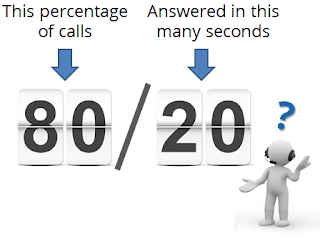Grade of Service (GoS) as a Service Level Measurement
The phrase
“Grade of Service” has been the grim reaper of the contact center industry for many years. Most discussions around them are hardly of a friendly nature. Of the 100 or so grey hairs I have earned over the last few years probably 99 are as a result of chasing those golden numbers. It is often also called just “Service Level” although the reality is any KPI whether Grade of Service (GoS), Abandon rate, or Average Speed to Answer (ASA) is basically also a Service Level.
The Big Flaw in this KPI
GoS takes the variability of waiting time into account: it looks at the fraction of customers in the tail of the waiting time histogram, that is, the % of customer contact with which waiting times are exceeding a certain number (often 20 seconds). However, the amount by which it is exceeded is not taken into account: so if a customer waits 30 or 300000 seconds it will not not change the GoS %, if the “acceptable waiting time” is set to 20. This means that you can be happliy congratulating yourself that you have achieved your target of 80% of contact within 20 seconds, meanwhile 20% of your customer are extremely unhappy and are complaining.
The common Misconception
That it is priority number one for driving Customer Experience. There are enough articles around on that to excuse me from going into the detail around thatthat. My view on it is that while it may not be the thing that gets you a high CSAT rating or a tick in the NPS box – if you get it wrong it will be the thing that will give you a hiding when it comes to measuring customer experience.
Over the years my understanding of the measurement has changed – from being a strict measure of how many in what period to a balanced scorecard view. It is almost a real time indicator that shows that everything, at that point in time, is working out as planned and all is well with your contact center for that moment. The recipe being your plan, the individual elements being your ingredients, the customer demand your heat and the cake the result of your efforts (GoS). If you don’t follow the recipe or get the ingredients wrong your GoS with flop.
Grade of Service targeting seems to be a debatable issue as well. Some common misconceptions that I have found:
- Adjust your targets in-line with your average abandon rate – logic tells me this means frustrate your customers to the point where they are just about to give up and then answer. There is also a normal distribution around average abandon rates which means that there is a significant amount of customers who abandon before the mean generating repeat contacts or volumes into other channels.
- Reducing your GoS will save you cost. I have seen that the lower your Grade of Service is the more you will struggle to keep them within a specific band (operational efficiency) as your occupancy levels will increase and therefore your margin for error decreases. The slightest change outside plan inevitably leads to an avalanche of issues which lead to repeat contacts and increased volumes.
- Your WFM department owns the Grade of Service performance the reality is it is the responsibility of the contact center as a whole to play their individual roles and share in the accountability.
Some realities of GoS:
- Never use GoS as a stand-alone absolute indicator of your staffing levels there are many other variables to consider before making a judgement call on capacity. The number of times I have heard the sentence “90% GoS today – you are overstaffed.”
- If you are targeting 80% you have to accept that a GoS of 75% is just as good as 85% and similarly a GoS of 90% is just as bad as 70%. If not your GoS target is not a target but a minimum threshold and staffing has to be calculated accordingly.
To wrap it up, there are a number of critical elements, numbers and levels of insights required to run an operationally efficient contact center. Performance against your plan for the day and understanding the root causes of the deviations to enable your planning going forward to be more effective is the most critical part of operational efficiency. Managing your stakeholder through education and effective reporting will delay the onset of your natural highlights.
Final Note: there always is much debate in the contact indutry around which waiting time measure to choose: Grade of Service (GoS) or Average Speed to Answer (ASA) – if you would like to hear Ger Koole opinion then follow this link to his article on the matter: Which Waiting Time Measure To Choose.
Join the debate on Linkedin:



Responses